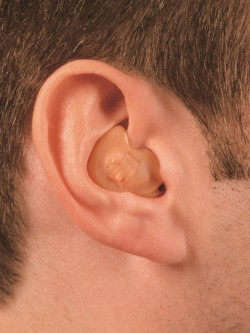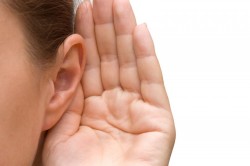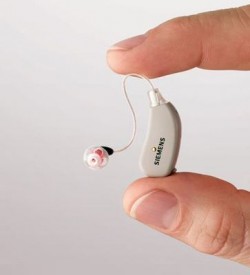With glasses, everything is more or less clear: you call the seller you need the number of diopters with a sign «minus» or «a plus» (depending on the myophesia you or hyperopia) and choose color and form the most suitable to your face of the rim. And how not to be mistaken in the choice of hearing aid?
Types of auditory aids

All hearing aids pursue one goal: to maximize the quality of sound and send this sound to your ear. Miscellaneous styles and forms of this device differ in size and placement in ear. Some of them are almost invisible - they are barely noticeable in the outer hearing aisle. Others, more, occupying a part of the external auditory passage, are easily distinguishable. Small devices are the most expensive, although they are discharged faster than large hearing aids.
Fully channel auditory apparatus (CIC).
This intracanal hearing aid is intended for adults, it completely repeats the shape of the channel of the external auditory passage. Make it, leaning on the client's ear. The small device is very powerful - it can significantly improve the quality of the perception of sound even at 4th degrees of hearing loss.
Nuances CIC:
- Almost noticeable in the ear.
- Practically does not catch wind noise, as it is protected by ear sink.
- Does not create obstacles to using the phone.
- The battery of the device after a week it is necessary to replace the new.
- This model does not regulate the volume and the microphone direction does not change.
- The device will not suit people who have broken membrane integrity.
Channel hearing aid (IT).
In size, this model exceeds a fully channel auditory apparatus, and therefore is not very deeply introduced into the outer hearing pass. Channel appliance for adults with moderate hearing loss.
Nuances IT:
- The device allows you to freely talk on the phone.
- The configuration of the device involves the additional use of the volume controller and the second microphone, which will make the machine large in size.
- Against the background of a small ear shell, the model may look cumbersome.
Konha and Polkontuha (ITE).
The device is located in the field of the external ear, occupying a complete ear sink or her half. Made it individually. The model will suit people suffering from moderate or big hearing loss.
ITE nuances:
- The device is available to surrounding - has no cosmetic effect.
- Catches wind noise.
- You can adjust the volume on this model.
- Easily inserted into the ear, unlike CIC.
- A large battery from which the device works for a long time.
Standing hearing aid.
The model is located behind the ear shell, fastening in its top. Catching the sound, the device enhances it and directs in the ear insert, located in the externally auditory passage. This type of device claims the title of universal: suitable and small, and adults, coping with most auditory disorders.
Nuances of the ear model:
- This device is the most noticeable of all, although in recent times its modification is somewhat «Produced» and made more elegant.
- Well coped with the amplification of sound - that is why at high hearing loss, ear hearing aids always use.
Open prosthetics apparatus.
The model is a miniature worm device. Sound Wave A Hearing Device through a thin wire feeds into a small receiver occupying an external hearing passage. Open prosthetics method leaves the outdoor part of the auditory pass free - this is a great solution to the problem of high-frequency hearing loss, when at low hearing frequencies «working» Almost no deviations.
Nuances of open prosthetics apparatus:
- Reliably hidden from prying eyes.
- Unlike internal models, it does not brave the auditory passage.
- The device serves miniature batteries.
- The tiny size of the apparatus does not allow the presence of manual regulators.
Hearing devices and digital technology

- You need to check the hearing of the doctor of the Surdian and listen to his recommendations about the suitable model of the hearing aid.
- The hearing center that you have chosen to purchase the apparatus must have a license. Recover with caution to little-known organizations that instead of high-quality hearing aids can sell dubious «Brand» Products. Also do not trust «Specialists», who argue that their products improve the rumor or completely eliminates the background noises. No auditory apparatus, even the highest quality, it is not.
- Interest, ask if the hearing aid has a test period, the so-called trial wearing. Sometimes it is not required day and not two to understand whether to you or another model of the device. In some centers of the audition, this service is free.
- Considering the peculiarity of the hearing to worsen over time, it will be useful to ask the doctor if the hearing apparatus has a choice.
- Any auditory apparatus must have a warranty period.
After the purchase

For some time you will need to get used to the auditory. Soon you will begin to feel comfortable enough, perceiving reinforced sounds.
Mirkets reminds you that:
- The auditory will not make your hearing normal and even to some extent will restore it, but only will increase the quiet sounds and eliminate the loud background noise;
- The auditory must be used in various situations and places to train the hearing for the perception of various sounds;
- Do not be afraid if you cannot manage the hearing aid you carry. The longer you use them, the faster you get used to him and in the future even stop noting him.









